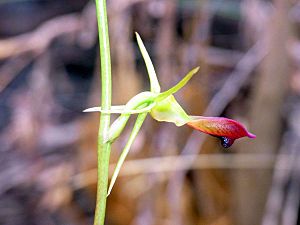Large tongue orchid facts for kids
Quick facts for kids Large tongue orchid |
|
|---|---|
 |
|
| Cryptostylis subulata in Ku-ring-gai Chase National Park | |
| Scientific classification | |
| Synonyms | |
|
The Cryptostylis subulata, also known as the large tongue orchid, duckbill orchid, or cow orchid, is a common plant. You can find it in many places across southeastern Australia and New Zealand. This orchid has fairly big, tough, dark green or yellowish-green leaves. It also grows up to twenty yellowish flowers. These flowers have a special part called a labellum that is reddish-brown and dark purple. You often see this orchid in wet or swampy areas, but it can also grow in drier spots.
Contents
What the Large Tongue Orchid Looks Like
The Cryptostylis subulata is a plant that grows from the ground. It is a perennial plant, meaning it lives for more than two years. It is also deciduous, so its leaves might fall off at certain times. This plant has tough, dark green or yellowish-green leaves. These leaves sit on stalks called petioles, which can be from 1 to 15 cm (0.5 to 6 in) long. The leaves are shaped like a spear, measuring 5 to 20 cm (2 to 8 in) long and 1 to 3 cm (0.5 to 1 in) wide.
Its flowers grow on tall stems called inflorescences. These stems appear from August to April and can be 50 to 80 cm (20 to 31 in) tall. Each stem can hold two to twenty individual flowers. Every flower has three green parts called sepals, which are 1.8 to 3 cm (0.7 to 1.2 in) long. It also has two petals, which are 1.0 to 1.3 cm (0.4 to 0.5 in) long and thinner than the sepals. The most interesting part is the labellum. It looks like a rolled-up tube and can be reddish-brown, purplish, or yellowish. It measures 1.5 to 3.5 cm (0.6 to 1.4 in) long and 0.5 to 1 cm (0.2 to 0.4 in) wide. On the bottom side of the labellum, there is a dark purple raised area called a callus that ends in two small bumps.
How the Large Tongue Orchid Got Its Name
The large tongue orchid was first officially described in 1806. A scientist named Jacques Labillardière studied a plant he found in Tasmania. He named it Malaxis subulata. He wrote about it in his book, Novae Hollandiae Plantarum Specimen. Later, in 1871, another scientist, H.G. Reichenbach, changed its name to Cryptostylis subulata. The second part of its name, subulata, comes from a Latin word. Subula means "awl", which is a pointed tool. This name likely refers to the shape of some part of the plant.
Where the Large Tongue Orchid Lives
This orchid can grow in many different types of soil. It can be found in sandy areas where water drains well. It also grows in wet, swampy places. You might even see it in dry eucalypt forests. It mostly lives in coastal areas of Queensland, New South Wales, Victoria, and Tasmania in Australia. You can also find it in the Blue Mountains. In New Zealand, it is only found in swamps north of Kaitaia and Taipa-Mangonui.
How the Large Tongue Orchid Reproduces
Like other Australian orchids in its group, the large tongue orchid has a special way of being pollinated. It is pollinated by a type of ichneumon wasp. This wasp is known as the orchid dupe wasp (Lissopimpla excelsa). The male wasps get tricked by the orchid's flowers. They mistake the flower parts for female wasps and try to mate with them. This helps the orchid spread its pollen.
Growing the Large Tongue Orchid
People who love orchids have been able to grow Cryptostylis subulata. However, it grows very slowly. The underground stems, called rhizomes, are quite delicate. They do not like to be moved or disturbed. Also, they need to stay moist all the time to grow well.

